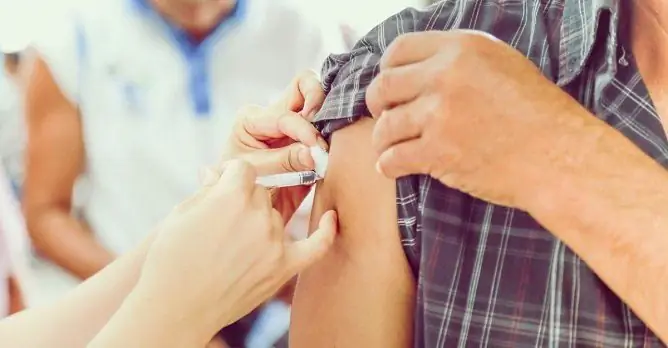- Author Rachel Wainwright [email protected].
- Public 2023-12-15 07:39.
- Last modified 2025-11-02 20:14.
Hawrix
Havrix: instructions for use and reviews
- 1. Release form and composition
- 2. Pharmacological properties
- 3. Indications for use
- 4. Contraindications
- 5. Method of application and dosage
- 6. Side effects
- 7. Overdose
- 8. Special instructions
- 9. Application during pregnancy and lactation
- 10. Use in childhood
- 11. Drug interactions
- 12. Analogs
- 13. Terms and conditions of storage
- 14. Terms of dispensing from pharmacies
- 15. Reviews
- 16. Price in pharmacies
Latin name: Havrix
ATX code: J07BC02
Active ingredient: antigen of the hepatitis A virus (hepatitis A virus antigen)
Producer: GlaxoSmithKline Biologicals (Belgium)
Description and photo update: 28.11.2018
Prices in pharmacies: from 820 rubles.
Buy

Hawrix is a vaccine to prevent hepatitis A.
Release form and composition
Havrix is produced in the form of a suspension for intramuscular (i / m) administration for children and a suspension for intramuscular (i / m) administration for adults: white, homogeneous consistency; during storage it is divided into two layers - a slowly precipitating white precipitate and a colorless supernatant [1 dose (0.5 ml - for children, 1 ml - for adults) in disposable syringes or colorless glass vials, in a cardboard box 1 syringe or 1 bottle and instructions for the use of Havrix; packing for hospitals - in a cardboard box 10, 25 or 100 bottles].
Composition of 1 dose of suspension:
- active substance: antigen of the hepatitis A virus (strain HM 175) * - 720 units. ELISA (0.5 ml) or 1440 units. ELISA (1 ml);
- auxiliary components: water for injection, potassium chloride, polysorbate 20, potassium dihydrogen phosphate, neomycin sulfate (trace content), sodium hydrogen phosphate, a mixture of amino acids, sodium chloride, 2-phenoxyethanol (preservative), aluminum hydroxide (sorbent).
* Virions of hepatitis A (strain HM 175) were grown in a culture of human diploid cells MRC5, concentrated, adsorbed on aluminum hydroxide, inactivated by formaldehyde.
Pharmacological properties
Pharmacodynamics
Havrix is a vaccine that provides prophylactic protection against hepatitis A virus (HAV) due to the formation of specific immunity by inducing the production of antibodies against HAV and by activating cellular immune mechanisms. Long-term preservation of immunity is provided by double vaccination with an interval of 6-12 months.
In special studies on the kinetics of the immune response, it was found that after a single administration of Havrix, an early and rapid seroconversion is achieved. As early as 13 days after vaccination, the number of patients with a protective antibody titer (> 20 mMU / ml) is 79%. As the period after the introduction of the vaccine increases, this figure increases significantly.
Long-term protection against HAV is provided by the introduction of a second dose (booster) 6-12 months after the primary immunization. Revaccination given 12-60 months later in individuals who received the primary Havrix vaccine also provides an adequate immune response.
The available data allow us to conclude that with a constant immune status of a person after a course of vaccination, including the introduction of the vaccination and revaccination doses, there is no need for repeated revaccination.
Pharmacokinetics
Havrix pharmacokinetic data were not provided.
Indications for use
Havrix is used to prevent hepatitis A in adults and children from the age of 12 months.
Contraindications
- symptoms of hypersensitivity during the previous administration of Havrix;
- known hypersensitivity to any component of the vaccine.
Temporary contraindications for vaccination are acute diseases (both infectious and non-infectious), as well as exacerbation of chronic diseases - until complete recovery or remission. In case of acute intestinal diseases and mild acute respiratory viral infections, the introduction of Havrix is allowed immediately after the normalization of body temperature.
The vaccine is not given in children under 12 months of age.
During pregnancy and lactation, vaccination is not recommended, since there is no information on the safety of using the Havrix vaccine during these periods of a woman's life.
Havrix, instructions for use: method and dosage
The vaccine is administered intramuscularly only. The suspension cannot be administered intravenously.
Before use, the drug should be visually inspected for changes in appearance and the presence of foreign particles. Immediately before administration, the vial / syringe must be shaken vigorously so that the liquid acquires a homogeneous structure (slightly cloudy, white). If the vaccine looks different, it is prohibited to use it.
Recommended vaccine injection sites: adults and older children - the deltoid area, children 12-24 months - the anterolateral thigh area. You should not inject the drug subcutaneously or into the gluteus muscle, since in such cases the formation of antibodies may not reach the required level.
For primary vaccination, a single dose for children under 16 years old is 0.5 ml (Havrix 720), for adolescents over 16 years old and adults - 1 ml (Havrix 1440).
To ensure long-term protection of the vaccinated, revaccination is best carried out 6-12 months after the primary immunization in doses appropriate to the patient's age.
If, for some reason, the revaccination was not carried out within 6-12 months, it is possible to administer the revaccination dose up to 60 months after the first dose.
Side effects
The safety profile is based on observation of over 5300 vaccinated people.
The incidence of adverse reactions is graded on the following scale: very often - ≥ 10%, often - from ≥ 1% to <10%, sometimes - from ≥ 0.1% to <1%, rarely - from ≥ 0.01% to < 0.1%, very rarely - <0.01%.
Side effects identified in clinical studies:
- general and local reactions: very often - pain and redness at the injection site, fatigue; often - swelling and induration at the injection site, fever (> 37.5 ° C), malaise; sometimes flu-like symptoms; rarely - chills;
- dermatological reactions: sometimes - rash; rarely - itching;
- infections and infestations: sometimes - rhinitis, upper respiratory tract infections;
- from the digestive system: often - nausea, diarrhea, vomiting;
- from the nervous system: very often - headache, irritability; often - drowsiness; sometimes dizziness; rarely - paresthesia, decreased sensitivity;
- from the musculoskeletal system: sometimes - musculoskeletal tension, myalgia;
- on the part of metabolism and nutrition: often - loss of appetite.
Side effects recorded during post-registration studies:
- allergic reactions: urticaria, angioedema, erythema multiforme;
- from the nervous system: convulsions;
- from the musculoskeletal system: arthralgia;
- on the part of the cardiovascular system: vasculitis;
- on the part of the immune system: anaphylaxis, allergic reactions, including anaphylactoid reactions and symptoms of an allergic condition resembling signs of serum sickness.
Overdose
Overdose cases were identified during post-registration observation. Symptoms were similar to those seen with the recommended dose of the vaccine.
special instructions
Havrix is a vaccine for the prevention of hepatitis A virus, and therefore does not provide protection against hepatitis caused by other pathogens such as hepatitis B virus, hepatitis C virus and hepatitis E virus, or other known pathogens that affect the liver.
Vaccination against the hepatitis A virus is recommended for all groups of the population, but it is especially indicated for people with an increased risk of infection, as well as for patients who, if the disease develops, can have a severe course, and people who, if infected with hepatitis A, due to their professional activities, can lead to the occurrence of outbreaks. Risk categories include:
- people living in areas with a high incidence of hepatitis A;
- persons at risk of occupational infection: nursing staff, medical workers (especially employees of infectious diseases, pediatric and gastroenterological departments), personnel of preschool institutions, employees of catering and food industries, workers of sewage and water supply services;
- people traveling to areas with a high incidence of hepatitis A (travelers, military personnel, etc.);
- persons from special risk groups: patients who have chronic liver disease or an increased likelihood of liver disease, hemophilia, multiple blood transfusions, as well as persons leading a promiscuous sex life, homosexuals, drug addicts;
- persons in contact with the outbreaks. With post-exposure prophylaxis, the introduction of Havrix does not give a 100% guarantee of protection against the hepatitis A virus. The effectiveness depends on the time elapsed since contact with the infected person, the amount of the infectious dose and the predicted state of health of the vaccinated patient.
Vaccination with caution should be given to patients with existing bleeding disorders or thrombocytopenia, as they have a risk of bleeding at the injection site. After the vaccine administration, such patients are recommended to apply a pressure bandage for at least 2 minutes. Do not rub the injection site. For this category of patients, it is allowed to inject Havrix subcutaneously.
Patients who have impaired immune system and patients on hemodialysis, a single administration of the vaccine does not always allow to achieve an adequate antibody titer, therefore, additional doses may be required.
In the vaccination room, the necessary means must be provided for stopping a possible anaphylactic reaction. For at least 30 minutes after the Havrix vaccination, the vaccinated person must be under medical supervision.
Influence on the ability to drive vehicles and complex mechanisms
Given the safety profile of the vaccine, it is unlikely that Havrix will adversely affect concentration and reaction rates.
Application during pregnancy and lactation
The risk of exposure to the inactivated vaccine on the fetus and child is minimal, but adequately controlled studies have not been conducted, therefore it is not recommended to vaccinate pregnant and breastfeeding women.
Pediatric use
The vaccine is used according to indications in children from the age of 12 months: Havrix 720 is prescribed for children under the age of 16, Havrix 1440 is prescribed for adolescents over 16 years of age.
Drug interactions
Havrix vaccine can be administered simultaneously with other inactivated vaccines provided for by the National Calendar of Preventive Vaccinations of the Russian Federation and the calendar of vaccinations for epidemic indications of the Russian Federation.
There was no decrease in the immune response with the simultaneous administration of inactivated vaccines against typhoid fever, cholera, tetanus, yellow fever, as well as with the introduction of human immunoglobulins.
If it is necessary to use other vaccines or immunoglobulins together, the drugs should be injected with different syringes in different parts of the body.
Analogs
Havrix analogs are: Avaxim, Avaxim 80, Algavak M, Vakta.
Terms and conditions of storage
Store and transport at 2-8 ° C. Do not freeze. Keep out of the reach of children.
The shelf life is 3 years.
Terms of dispensing from pharmacies
Dispensed by prescription.
Cardboard boxes of 10, 25 and 100 bottles are dispensed only in medical institutions.
Reviews about Havrix
Reviews about Havrix are positive. This vaccine prevents the development of hepatitis A (an acute infectious liver disease), is well tolerated, and does not cause serious side effects. Immunization is especially recommended for people at risk, including travelers planning a trip to a country with high HAV endemicity.
Havrix is an inactivated vaccine (does not contain live microorganisms), which forms immunity for almost all life. Vaccination against HAV is not included in the calendar of mandatory vaccinations, so whether to put it or not is an individual choice of each person. However, many consciously choose to immunize both their children and themselves, because they believe that health is more important than money spent.
Of the negative reactions, a slight increase in body temperature on the day of vaccine administration is most often mentioned.
Price for Havrix in pharmacies
Approximate prices for Havrix are: 1 dose of 720 U - 881 rubles, 1 dose of 1440 U - 1648 rubles.
Havrix: prices in online pharmacies
|
Drug name Price Pharmacy |
|
Havrix (inactivated hepatitis A vaccine) 720 UNITS suspension for intramuscular administration for children 0.5 ml 1 pc. 820 RUB Buy |
|
Havrix (inactivated hepatitis A vaccine) 1440 IU suspension for intramuscular administration 1 ml 1 pc. 1379 RUB Buy |

Maria Kulkes Medical journalist About the author
Education: First Moscow State Medical University named after I. M. Sechenov, specialty "General Medicine".
Information about the drug is generalized, provided for informational purposes only and does not replace the official instructions. Self-medication is hazardous to health!






